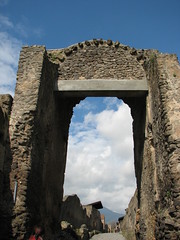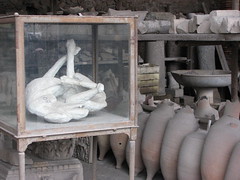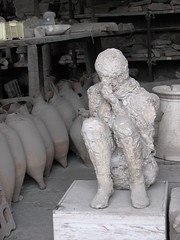Campania, Italy – Friday, March 5th, 2010
“You’re American, aren’t you?”
“Yes, I am.”
“There’s a couple of old buildings around the next block. You should have a look at them, all you Americans love looking at old stuff, yeah?”
This exchange took place long after I had left Italy for the UK, and at the time I had to laugh at the silliness of his stereotype. But part of what made it so amusing was the kernel of truth in it: Americans do like looking old things.
Can we help ourselves? We come from a country where if a building or structure is older than our grandfather it has deep historical significance. The oldest European settlements on the North American continent only date back to the 1600’s, which sounds positively prehistoric if you’re  from Michigan, and even then all that’s left of it is a plaque next to some scattered stones and a re-enactment village on the field next to it. Live in London any your local pub might predate the founding of Jamestown by several decades.
from Michigan, and even then all that’s left of it is a plaque next to some scattered stones and a re-enactment village on the field next to it. Live in London any your local pub might predate the founding of Jamestown by several decades.
Imagine then the power of the collective murmur that escaped the lips of every student when we all first entered the guarding walls of Pompeii and found an entire preserved Roman city covered by volcanic ash in 79AD, stretching for what appeared to be miles ahead of us.
Before the slideshow, a note. The bodies you see are not real: the organic tissue has all long since dissolved in the ash, leaving only the empty cavities in their wake. When digging through the ash, if an empty spot is found, a small hole is made which plaster is poured into, and once dried the ash is pushed away. You’ll also notice most of the casts have their nose and mouth covered; this wasn’t because of the ash, but because of the toxic fumes released from Vesuvius (this is the same reason why airplanes weren’t allowed to fly for months after the Eyjafjallajökull volcano).
 Maybe it felt happier before it became covered in an ash cloud of death, but Pompeii to me felt like a very eerie, oppressive place, with stone walls blocking in every street and no signs of any natural life besides the few weeds and moss that sneak through the cracks. There were few opportunities for green spaces, just endless rows of gray stone, very claustrophobic. The architectural brutalists of the 1960’s would have been proud.
Maybe it felt happier before it became covered in an ash cloud of death, but Pompeii to me felt like a very eerie, oppressive place, with stone walls blocking in every street and no signs of any natural life besides the few weeds and moss that sneak through the cracks. There were few opportunities for green spaces, just endless rows of gray stone, very claustrophobic. The architectural brutalists of the 1960’s would have been proud.
Still, that would be generalizing too much. There were a few open gathering places with verandas and fountains, and an anfiteatro (a smaller version of the Roman Colosseum, as every ancient Roman city had one) as well as some nicer shops and homes which still had preserved frescos on the walls and mosaic tile counters. Later in the tour we got to visit the Villa, bathhouse, and brothel, all essential parts of the ancient Roman’s daily lives. Most surprising of all however was rounding a corner after miles of abandoned stone buildings to encounter one with a fully-modernized Autogrill located inside. We finished with the Pompeii Forum, nearby where the famous cast of a writhing dog unable to escape from its leash is placed. Overall I’d say Pompeii is worth a visit while in Italy for the sheer historical spectacle on such an unimaginably large scale, although like anything that’s old, expect a few flavors of touristy things on the outskirts. Best of all, since it was organized by the school, the entire day including busing to/from Rome only cost me €20 for the whole trip (minus the pizza).
Later in the tour we got to visit the Villa, bathhouse, and brothel, all essential parts of the ancient Roman’s daily lives. Most surprising of all however was rounding a corner after miles of abandoned stone buildings to encounter one with a fully-modernized Autogrill located inside. We finished with the Pompeii Forum, nearby where the famous cast of a writhing dog unable to escape from its leash is placed. Overall I’d say Pompeii is worth a visit while in Italy for the sheer historical spectacle on such an unimaginably large scale, although like anything that’s old, expect a few flavors of touristy things on the outskirts. Best of all, since it was organized by the school, the entire day including busing to/from Rome only cost me €20 for the whole trip (minus the pizza).

Comments